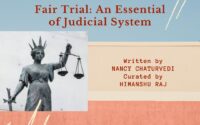TKDL: A REVOLUTIONARY IMPACT ON THE IPR INDUSTRY
This article has been written by Ipsita Rout from KIIT School of Law and has been curated by Yashasvi Kanodia from NMIMS Kirit P. Mehta School of Law.
From Academics to Scholars, Students to Teachers, Doctors to Scientists – every profession on earth has had a history. An era where the struggles of man were only written in fine print or were folklore, man was still finding a way to channelize all the pieces of the puzzle and technology manoeuvred man this transformation. Like, they say, little knowledge is dangerous, with the advancement of time we are the future to dusty chalkboards. Books, old manuscripts, phonebooks, mail, journals, and more- all the information you need is a click away, digitalisation in every sector possible and the augment of AI has made everything much less sophisticated. In this article we shall visit the TRADITIONAL KNOWLEDGE DIGITAL LIBRARY (TKDL) that has taken the Intellectual Property Industry to an all-time summit. But, nothing that makes our lives easier has ever come without its challenges.
INTRODUCTION
Traditional knowledge is the delicate and sacred information acquired and established by tribal groups which is passed from one community to another, and this consists of medicinal, agricultural and environmental experience. The nature of this information is sui generis and is open to threat due to danger to the identity of those tribes and communities. Traditional knowledge is distinct, and it is a hybrid between intellectual property and public domain, possessing characteristics and being subject to the constraints of both. Owing to the absence of qualities such as invention, recognizable owner, and so on, proprietary intellectual property rights (‘IPR’) cannot be held over such technology, it becomes part of the public domain, where it can be used. As a result, safeguarding conventional information has proved to be a difficult challenge.
IMPACT AND IMPORTANCE
Traditional knowledge is described by the World Intellectual Property Organization (WIPO) as “a growing body of knowledge passed down to the next generation within a community.” It is often a part of a person’s spiritual and cultural identity.’ Yoga or the medicinal powers of turmeric or tulsi, for example, would be part of our cultural wisdom for Indians. One of its distinguishing features is that this information has been passed on over the generations by word of mouth. It could be published anywhere or not. The Ministry of AYUSH (Ayurveda, Yoga and Naturopathy, Unani, Siddha and Homeopathy), in cooperation with the Ministry of Health and Family Welfare and the Centre for Scientific and Industrial Research, has launched the Traditional Knowledge Digital Library (TKDL) (hereinafter referred to as CSIR).
It was enacted in 2001 to prohibit overseas patents being granted for conventional Indian knowledge. The library was founded after the Indian government had to expend a significant sum of taxpayer money to get a patent awarded to the University of Mississippi by the USPTO revoked. Protecting the unique expertise that developed countries like India possess is critical because it will allow them to make their development process more sustainable. It will assist them in achieving their desired socio-cultural success stages. The TKDL’s implementation and formulation also aided in the protection of our science from bio-piracy while also bringing common knowledge into the mainstream. It also made it possible for overseas patent offices to deny trademarks to those attempting to infringe on ethnic groups’ interests.
Since it was established with the aim of helping indigenous peoples, TKDL has obtained significant funding from the government. Since it does not execute the other roles of an IPR regime, it currently serves only as a defensive weapon, as enticing as it can sound. In most cases, an IPR regime has a dual purpose: it protects intellectual property while also providing monetary compensation. The current TKDL architecture only serves one of the purposes of protecting information, but it does not have any incentives to its owners.
CRITICISM
For starters, TKDL does not allow access to third parties, so there is little financial advantage to be gained from a contractual arrangement. Only the CSIR and the Patent Offices, who enter into the ‘Free Access Agreements,’ have a contractual arrangement. Second, it fails to benefit the real winners, the initial traditional wisdom holders, aboriginal peoples. Third, common information is not recognized by the TKDL as a part of the public domain that is not publicly available. As a result, commercialization is proposed to address the shortcomings of the current TKDL system. The primary goal of knowledge is to spread it, which can be obtained upon methodological foundation for selling conventional knowledge to third parties. Furthermore, commercialization will ensure the preservation of cultural knowledge while also benefiting aboriginal peoples financially. Traditional information commercialization has been debated before, but due to a lack of a protocol and a concrete record, it has never been prosecuted. However, with the existence of provisions for access value sharing under different treaties, as well as the BD Act and the TKDL, commercialization of common information under the TKDL can now be considered a possibility. Commercialization of information under the TKDL would result in financial gain, which could be put into the wellbeing of indigenous peoples.
MODERN DAY THREATS
Traditional knowledge, even as a resource to be communicated, is knowledge in and of itself, and thus has added value. Traditional wisdom is regarded as a shared property, and therefore its preservation is regarded as a shared responsibility that is easily overlooked by individual conscience. As a result, the need to defend, though felt, becomes a responsibility that others must fulfil. A person’s short-sightedness is what contributes to the loss of conventional wisdom, so this poses a significant challenge to its conservation and security.
India’s experiment with defending traditional knowledge gained popularity in the early 1990s, sparked by fears of biopiracy, lack of access, and the catastrophe of the resources. This ultimately led to India’s TKDL initiative, which dates back to 1995, when two expatriate Indians at the University of Mississippi Medical Center applied for a patent for turmeric’s wound-healing properties. After the patent was awarded, the CSIR successfully contested it, arguing that this material was part of India’s common expertise and that seeking a patent for it would be biopiracy. As a result, the patent that had been awarded was revoked.
A second patent lawsuit was contested along familiar ground by the Agricultural and Processed Food Exports Development Authority against the United States Patent Office in the matter of a patent to RiceTec, a US company that had submitted a request to name its brand of rice ‘Texmati,’ after the popular Indian Basmati. A patent for this rice variety was filed under the name “America’s Basmati.” Documents obtained by the Indian Agricultural Research Institute effectively refuted RiceTec’s arguments, demonstrating that the Basmati variety is part of India’s conventional expertise.
CONCLUSION
The scope of the TKDL is enormous, and it is perhaps the most significant step taken by the Indian government to preserve traditional information. It has the potential to act as an adhesive in reconciling indigenous peoples’ belief systems with the IPR Regime’s ideals, resulting in a technique that is feasible for all.


